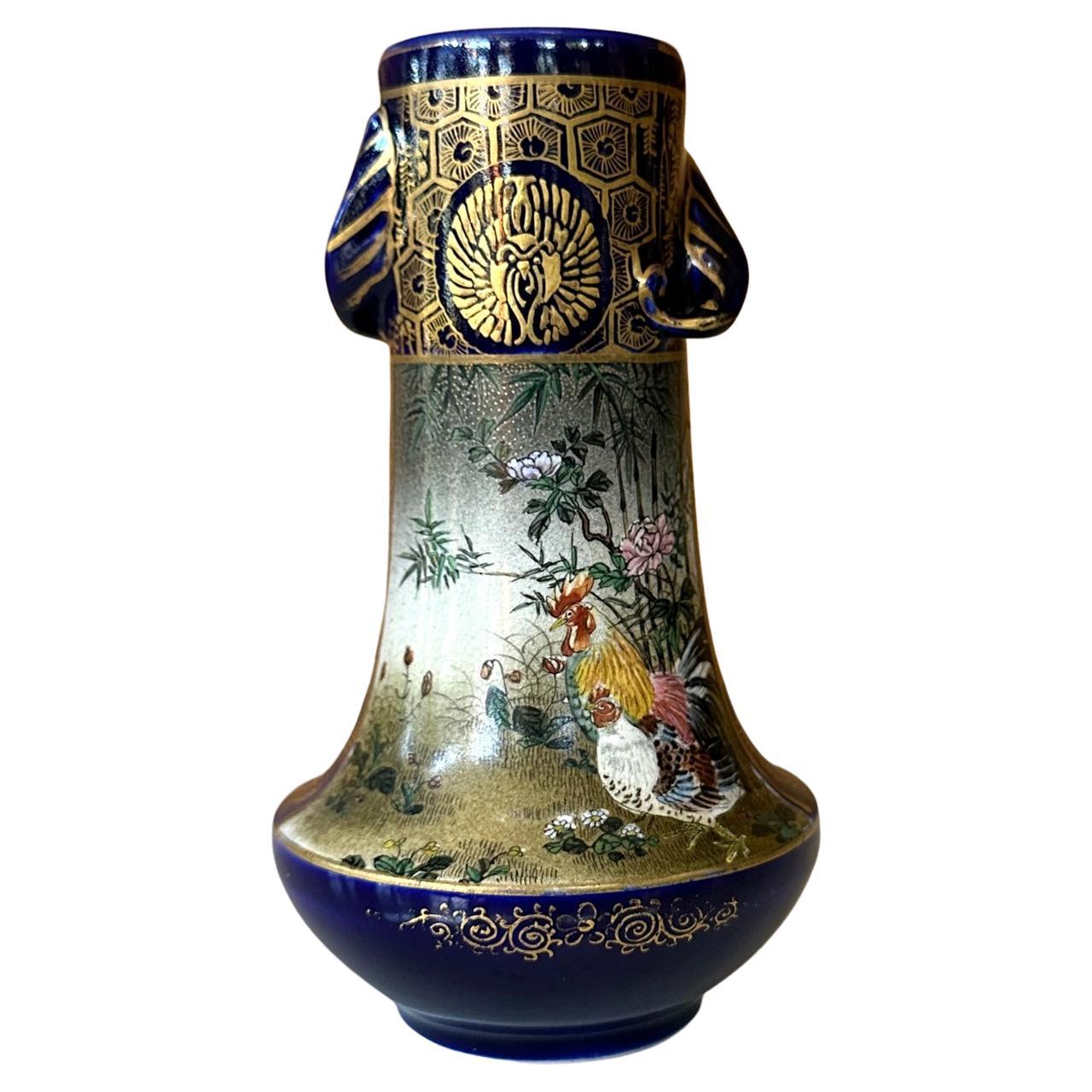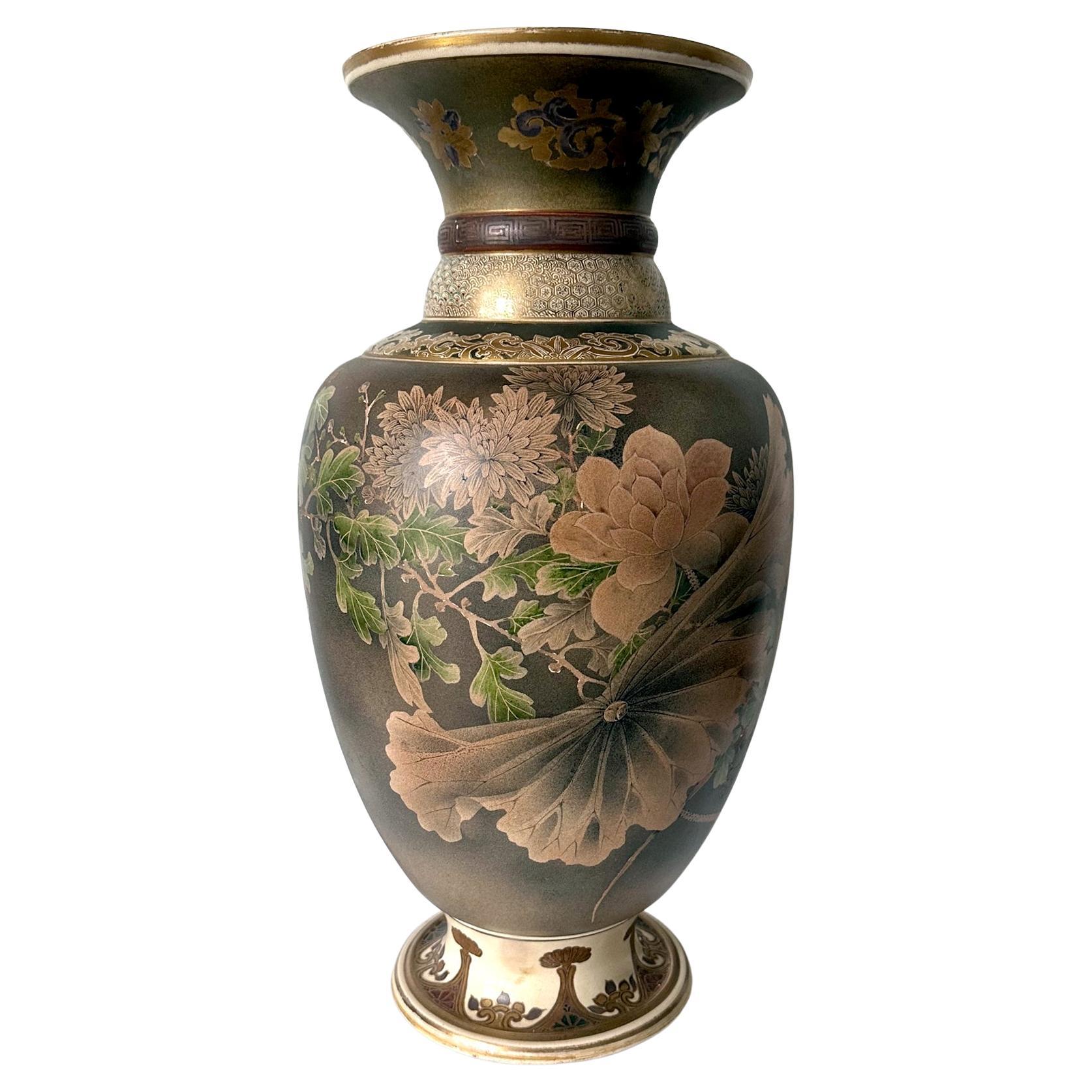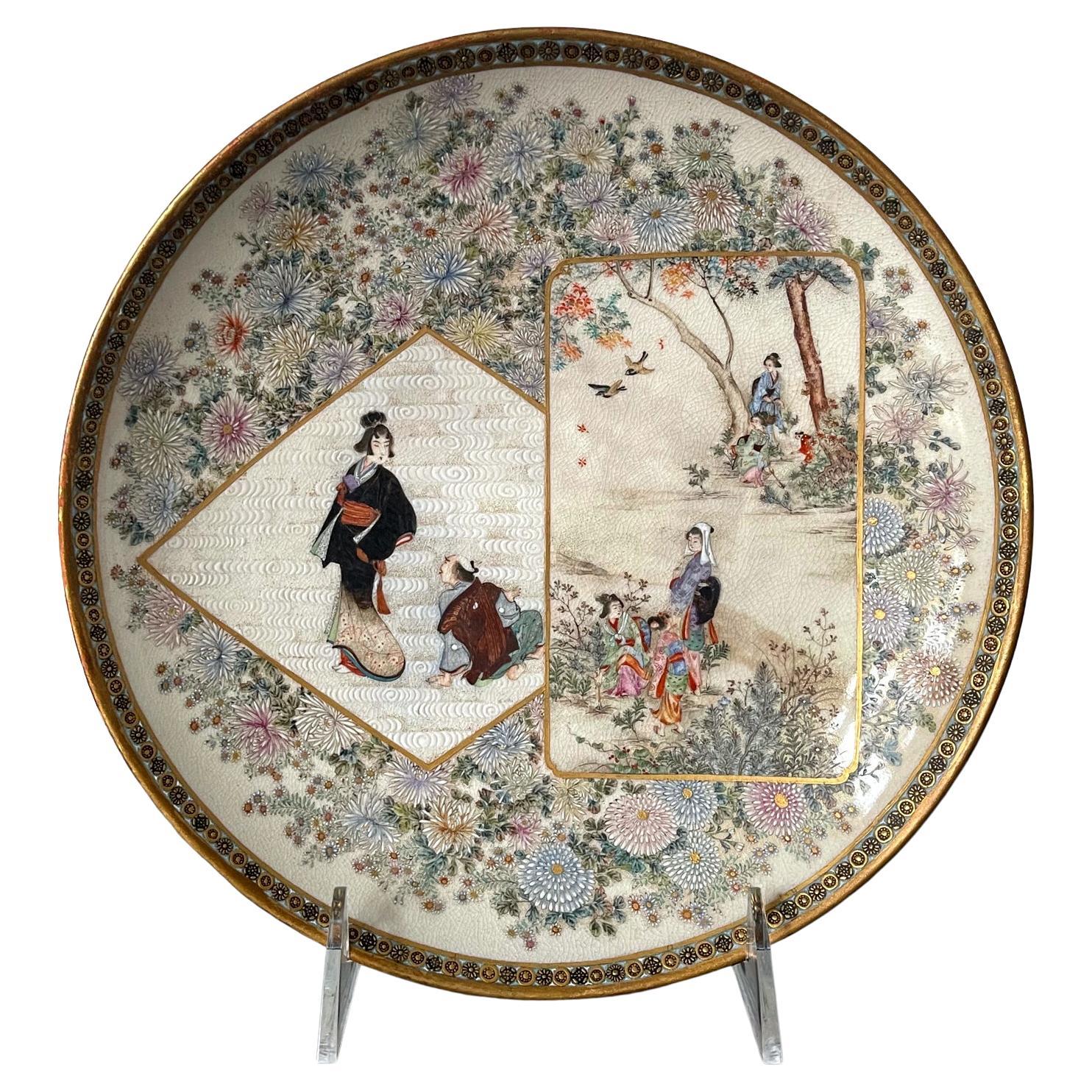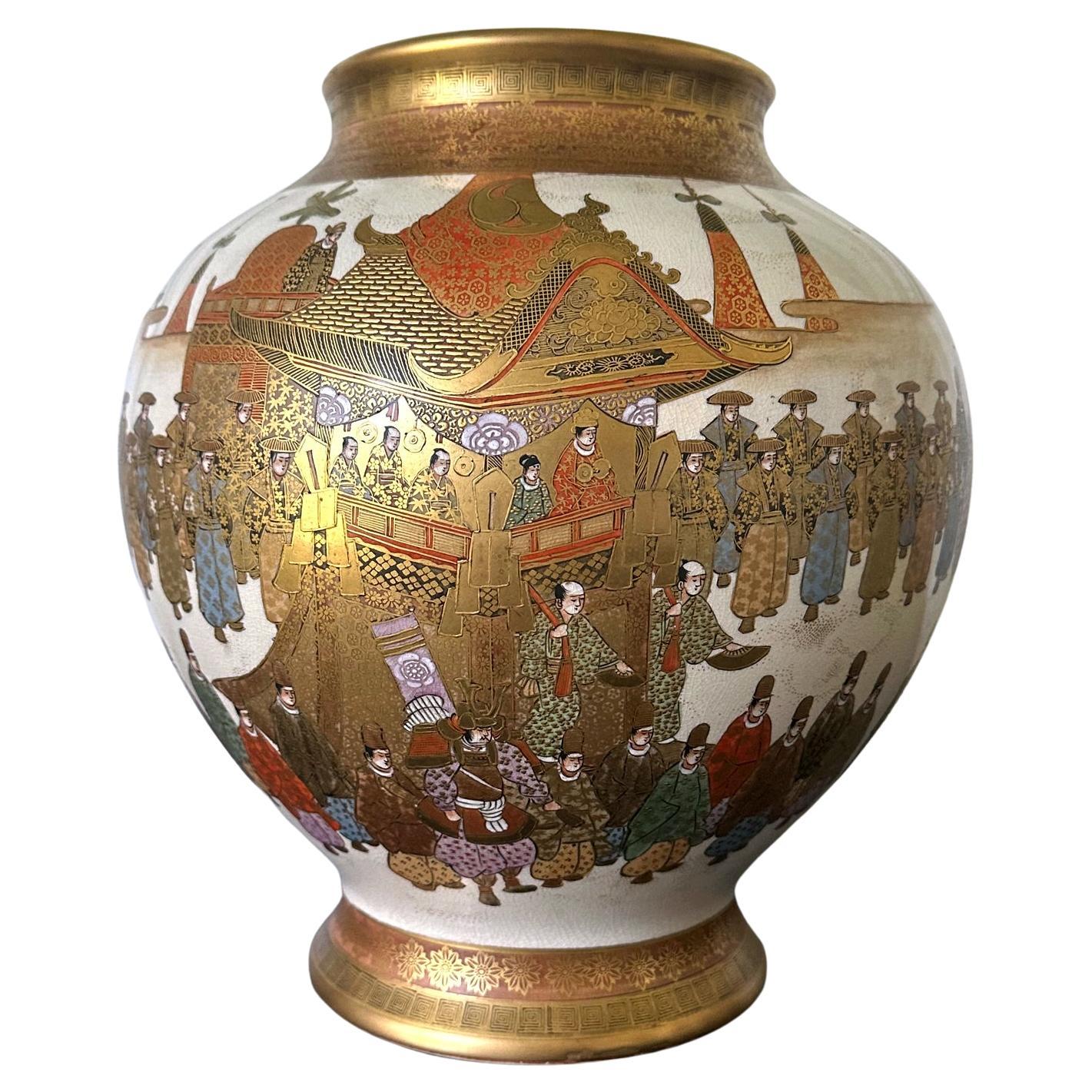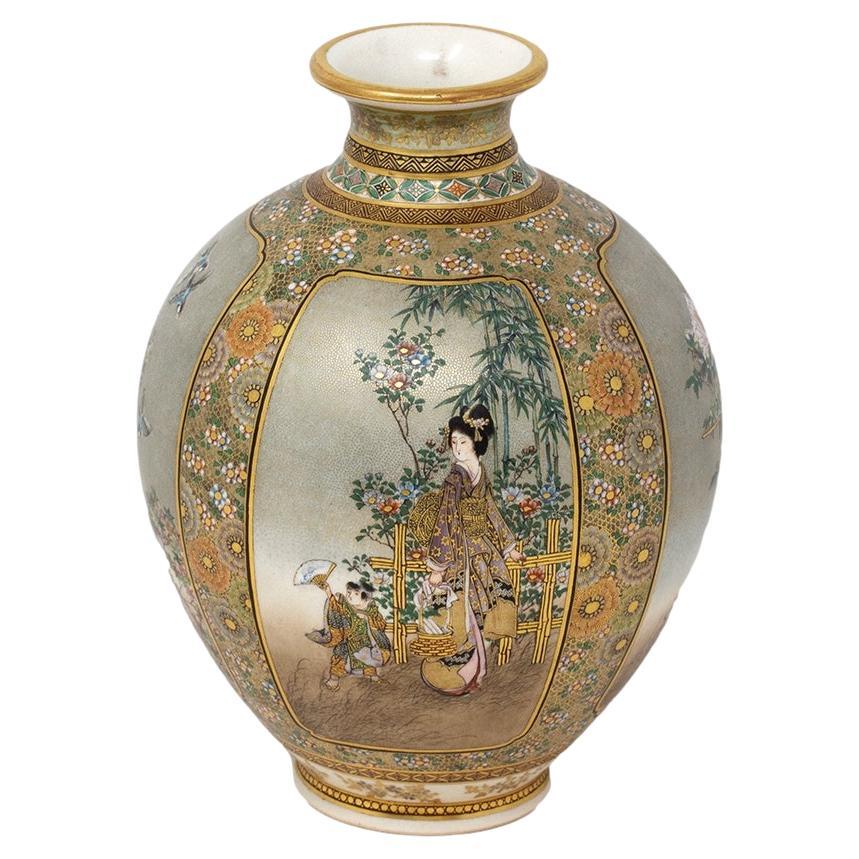Items Similar to Fine Japanese Satsuma Ceramic Vase by Kinkozan
Want more images or videos?
Request additional images or videos from the seller
1 of 8
Fine Japanese Satsuma Ceramic Vase by Kinkozan
About the Item
As part of our Japanese works of art collection we are delighted to offer this finely decorated Meiji Period (1868-1912) Satsuma vase stemming from the highly regarded Kinkozan studios in Kyoto. The vase is unusually decorated with a swarm of gilt dragonfly's amidst vibrantly coloured native flora all decorated upon a fine gilt speckled ground, the tranquil scene bordered by a formal geometric band to the base as well as multiple bands of floral and diaper decoration to the shoulders and neck, the underside of this beautiful cabinet vase still carries the original company label as well as a gilt signature and impressed seal for Kinkozan of Kyoto. A perfect addition to any serious Japanese Satsuma collection.
Condition report :
Lovely condition.
Approximate sizes :
Height : 6 1/8" 15.5 cm
Diameter : 3" 7.5 cm
Free worldwide delivery and a certificate of authenticity are included within the price of this item. EP85
- Creator:Kinkozan (Artist)
- Dimensions:Height: 6.13 in (15.58 cm)Width: 3 in (7.62 cm)Depth: 3 in (7.62 cm)
- Style:Meiji (Of the Period)
- Materials and Techniques:
- Place of Origin:
- Period:
- Date of Manufacture:1900
- Condition:Wear consistent with age and use.
- Seller Location:Christchurch, GB
- Reference Number:
About the Seller
5.0
Vetted Seller
These experienced sellers undergo a comprehensive evaluation by our team of in-house experts.
Established in 2011
1stDibs seller since 2023
Typical response time: 1 hour
- ShippingRetrieving quote...Ships From: Christchurch, United Kingdom
- Return PolicyA return for this item may be initiated within 14 days of delivery.
More From This SellerView All
- Large Japanese Satsuma Vase by KinkozanBy KinkozanLocated in Christchurch, GBAs part of our Japanese works of art collection we are delighted to offer this finely decorated Meiji Period (1868-1912), Satsuma vase stemming from the highly regarded Kinkozan stud...Category
Antique Late 19th Century Japanese Meiji Ceramics
MaterialsCeramic
- Fine Japanese Satsuma Bowl – Matsumoto ShozanLocated in Christchurch, GBAs part of our Japanese works of art collection we are delighted to offer this extremely fine quality Meiji Period (1868-1912) Satsuma bowl, the underside artist signed by Matsumoto ...Category
Antique 19th Century Japanese Meiji Ceramics
MaterialsCeramic
- Japanese Ceramic Vase by Makuzu KozanBy Makuzu Kozan IILocated in Christchurch, GBAs part of our Japanese works of art collection we are delighted to offer this charming Meiji Period 1868-1912, ceramic baluster vase from the studios of the highly coveted Imperial ...Category
Antique 19th Century Japanese Meiji Ceramics
MaterialsCeramic
- Large Japanese Ceramic Vase by Makuzu KozanLocated in Christchurch, GBAs part of our Japanese works of art collection we are delighted to offer this tapering square form Meiji Period 1868-1912, ceramic vase from the studios of the highly coveted Imperi...Category
Antique 19th Century Japanese Ceramics
MaterialsCeramic
- Large Japanese Ceramic Charger by Fukagawa Seiji CompanyBy FukagawaLocated in Christchurch, GBs part of our Japanese works of art collection we are delighted to offer this large Meiji Period (1868-1912) ceramic charger made under the banner of the Fukagawa Seiji Gaisha, a bre...Category
Antique Late 19th Century Japanese Meiji Ceramics
MaterialsCeramic
- Unusual Japanese Studio Vase by Makuzu Kozan IIBy Makuzu Kozan IILocated in Christchurch, GBAs part of our Japanese works of art collection we are delighted to offer this most unusual Late Meiji (1868-1912) early Taisho period (1912-1926 ), globular vase stemming from the h...Category
Vintage 1920s Japanese Taisho Ceramics
MaterialsEarthenware
You May Also Like
- Fine Japanese Ceramic Satsuma Vase by KinkozanBy KinkozanLocated in Atlanta, GAA miniature Japanese ceramic vase from the end of Meiji period circa 1880s- 1910s by Kinkozan (1645-1927). One of the largest studio manufacturers of the export ceramics at the time ...Category
Early 20th Century Japanese Meiji Ceramics
MaterialsCeramic
- Large Japanese Satsuma Ceramic Vase KinkozanBy KinkozanLocated in Atlanta, GAA large Japanese ceramic vase from the end of Meiji period circa 1890-1910s by Kinkozan (1645-1927). One of the largest studio manufacturers of the export ceramics at the time based in Kyoto. In the typical style of satsuma made at the turn of 20th century, the vase is elaborately decorated with a rather unusual kinran-de (gold paint) and green enamel highlight on a mottled brown background. The painterly decoration depicts a large seasonal floral arrangement in a circular fashion. Besides the obviously superb craftsmanship, what sets this particular vase apart from many lower quality and mass-produced pieces is its tone-on-tone color pallet that is visually somber and the small and sensitive details that heralds the change of the seasons. When the viewer goes beyond the first casual glimpse of the blossom and foliage, one would notice that on the edges of certain leaves as well as along the stalks, there accumulates a very thin layer of the white dust that represents the frost. The flower in bloom are chrysanthemums. Despite of being splendid, they are the messengers of the autumn. The large lotus leaf was subtly rendered in a bended and slightly withered manner, just past its prime. Although the lotus is still in bloom, the prominent seed pod indicates it may be the last for the season. The sentimental capture of the change of the seasons is not unusual in Japanese art. This vase poetically represents such a subtle transition from summer to fall, perhaps depicting the very first frost. The neck of the vase is also slightly unusual with two rolled rings...Category
Early 20th Century Japanese Meiji Ceramics
MaterialsCeramic
- Japanese Satsuma Ceramic Dish with Fine Decoration by KinkozanBy KinkozanLocated in Atlanta, GAA satsuma ceramic dish made by Kinkozan studio circa 1980-1900s in the late Meiji Period. The dish with a thick robust wall is supported by a large ring base and features finely deta...Category
Antique Late 19th Century Japanese Meiji Ceramics
MaterialsCeramic
- Fine Japanese Satsuma Ceramic Jar with Gilt Decoration by KinkozanBy KinkozanLocated in Atlanta, GAA large Japanese ceramic vase from end of Meiji period circa 1880s- 1910s by Kinkozan (1645-1927). One of the largest studio manufacturers of the export ceramics at the time based in Kyoto. In the typical style of satsuma made at the turn of 20th century, the vase is of a moon jar shape and finely decorated with kinran-de (gold paint) on a cream white background with even fine crackles. What sets this particular vase apart from many lower quality and mass-produced pieces is the meticulously renditioned surface decoration. Lavishly gilded with a continuous design, the carefully composed imagery depicts an elaborately decorated float cart in a festival parade. A group of people are seated within the float with a woman and a child standing in the front. Surrounding the float are streams of marchers dressed...Category
Early 20th Century Japanese Meiji Ceramics
MaterialsCeramic
- Japanese Meiji Period Satsuma Vase by KinkozanBy KinkozanLocated in Newark, EnglandThe vase is potted in globular form with a tightly pinched neck and rolled top rim beautifully decorated with four highly detailed individual panelled scenes. The first a Geisha bari...Category
Antique Late 19th Century Japanese Meiji Ceramics
MaterialsCeramic, Earthenware, Pottery
- Japanese Satsuma Natsume KinkozanBy KinkozanLocated in Newark, EnglandCobalt Blue Natsume From our Japanese collection, we are delighted to offer this Japanese Satsuma Natsume by Kinkozan. The Natsume of elongated rectangular form with four recessed panels each bordered by a gilt foliage decoration. The Natsume raised upon a square base with a scalloped centre. The top of the Satsuma finished with the original lid with matching gilt foliage decoration. The panels of the Satsuma decorated with multiple figures in various pursuits framed within a shaped recesses. The base of the Satsuma is signed with the Kinkozan mark. The Natsume dates to the Meiji Period (1868-1912) circa 1890. Natsume is a Chaki 茶器 (tea implement) used in a Japanese Tea Ceremony and is a term for a Japanese Tea Caddy...Category
Antique Late 19th Century Japanese Meiji Ceramics
MaterialsEnamel
Recently Viewed
View AllMore Ways To Browse
Chinese Porcelain Blue And White Chinese Porcelain
Chinese Nanking Vases
Asian Very Thin Porcelain Bowls
Japanese Satsuma Box
Imperial Nippon Hand Painted Vase
Antique Chinese Cloisonne Sold
Joseon Dynasty Pottery
Asian Green Glaze Pottery
Joseon Dynasty Furniture
Celadon Bird Motif
Chinese Porcelain Blanc De Chine Goddess Guanyin
Large White Italian Porcelain Asian Sculpture
Pair Of Chinese Flambe Foo Dogs
Porcelain Chinese Dragon Statue
Tung Chih
Yui Tsujimura
19c Chinese Export Blue White
8 Inch Female Foo Dog
